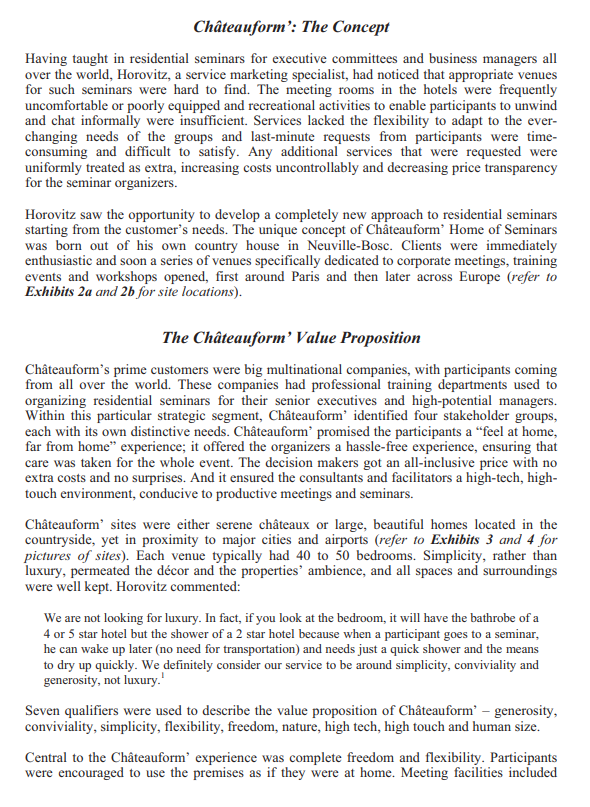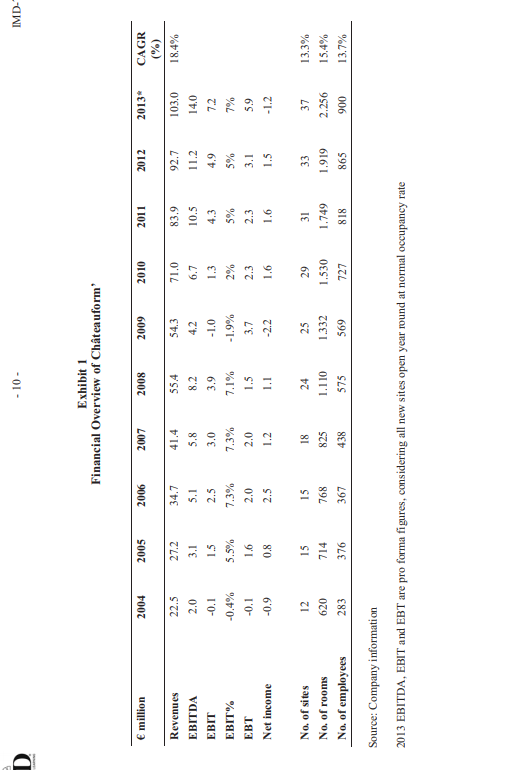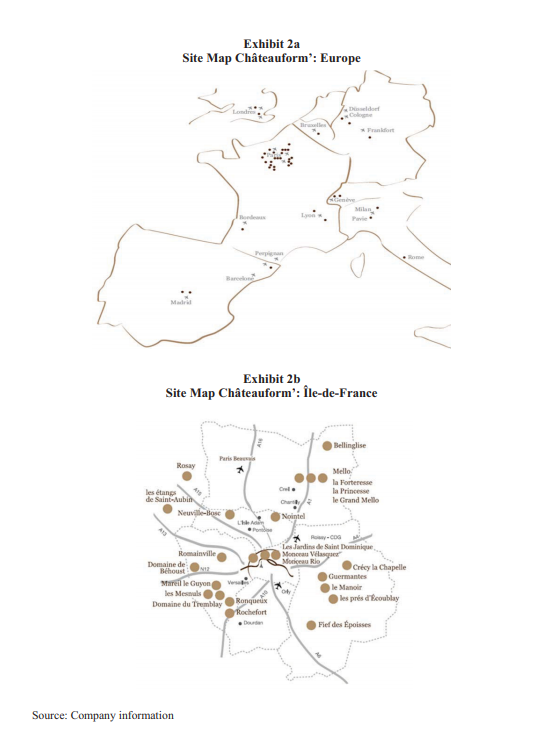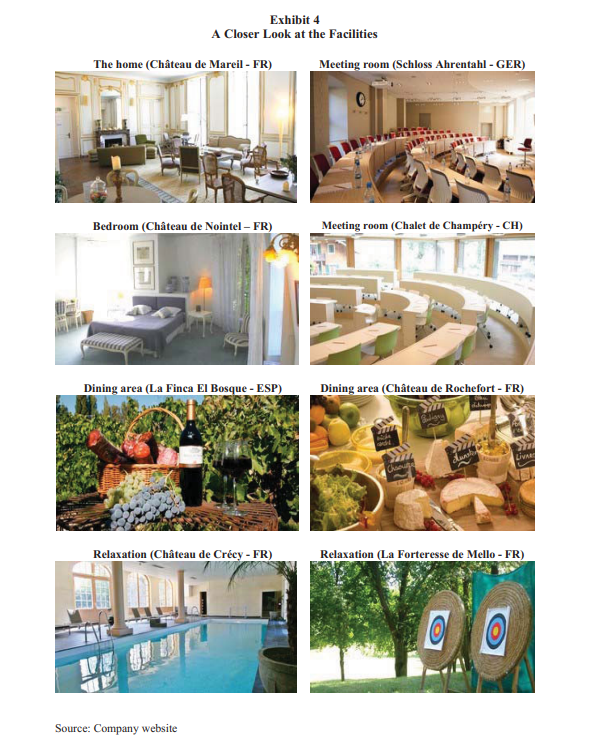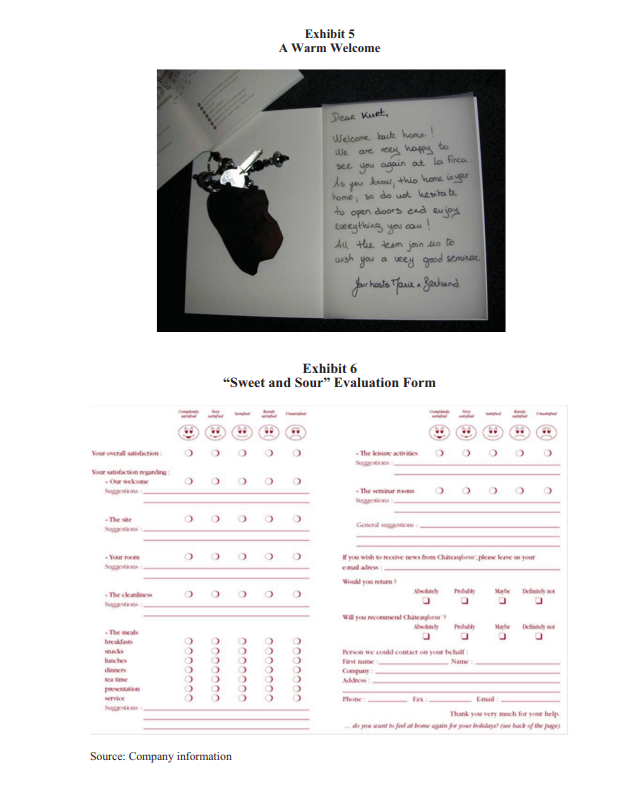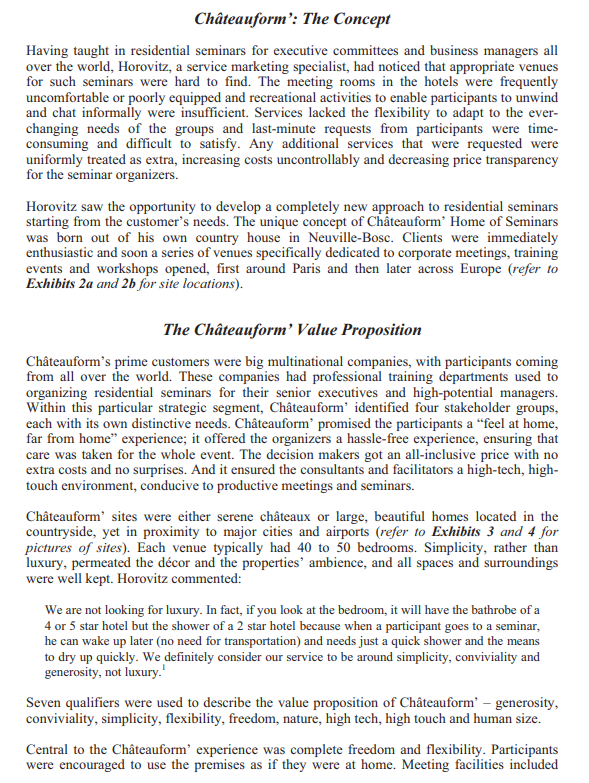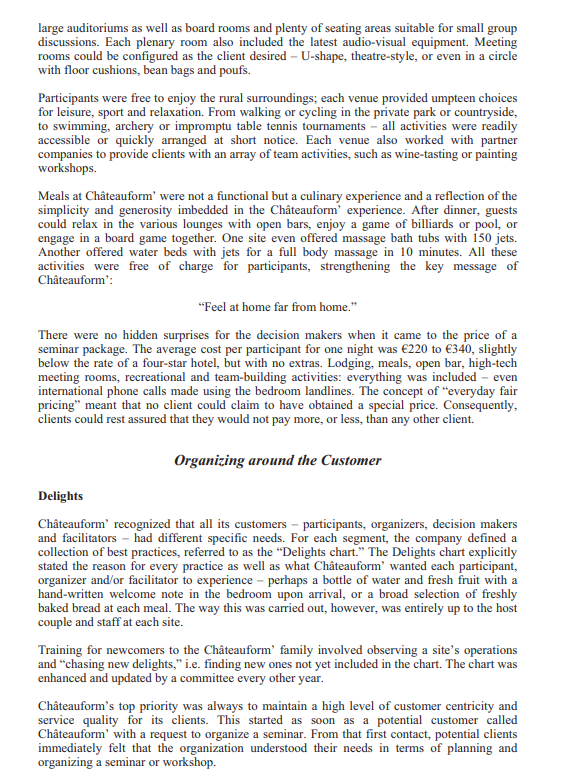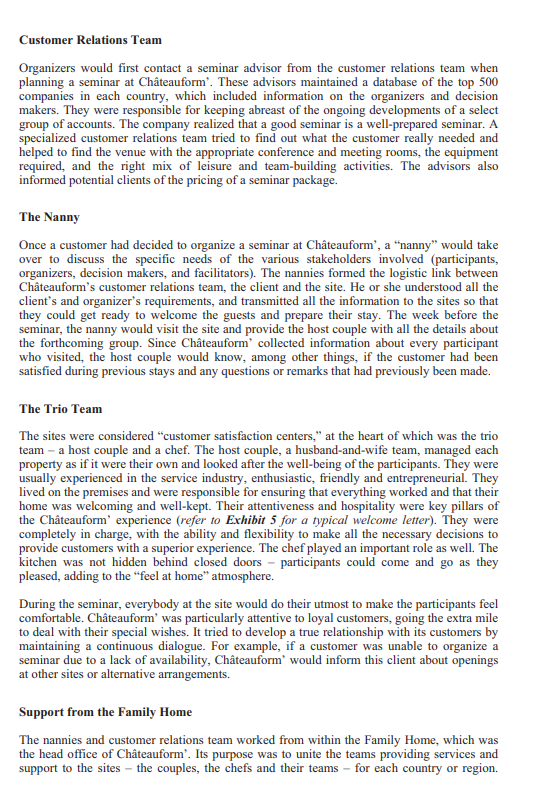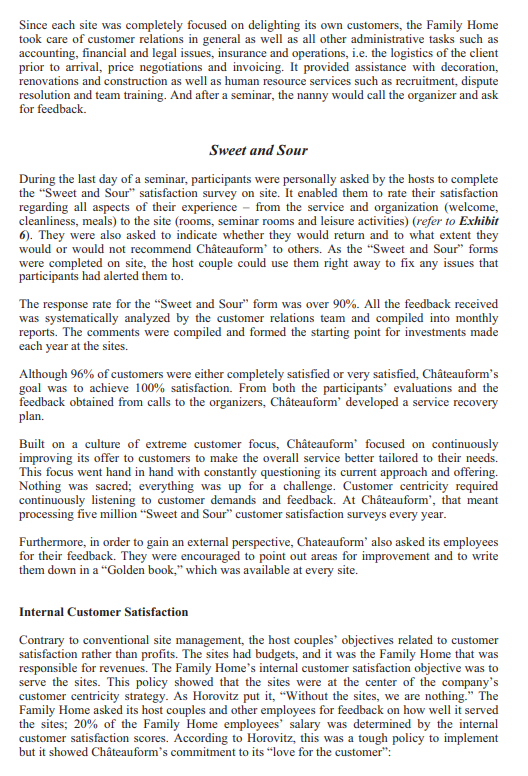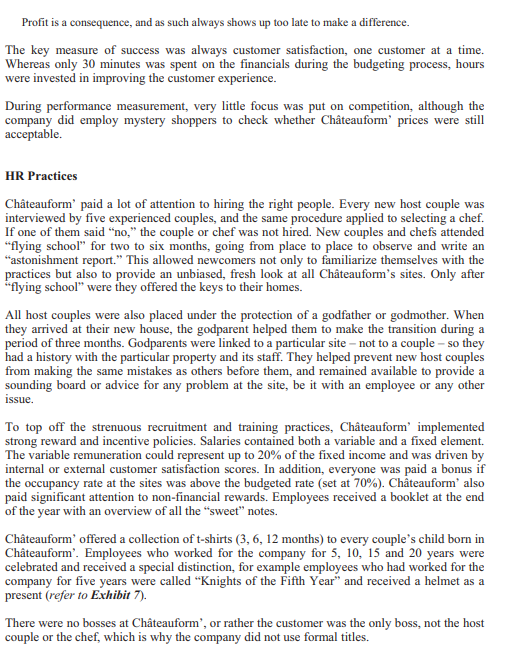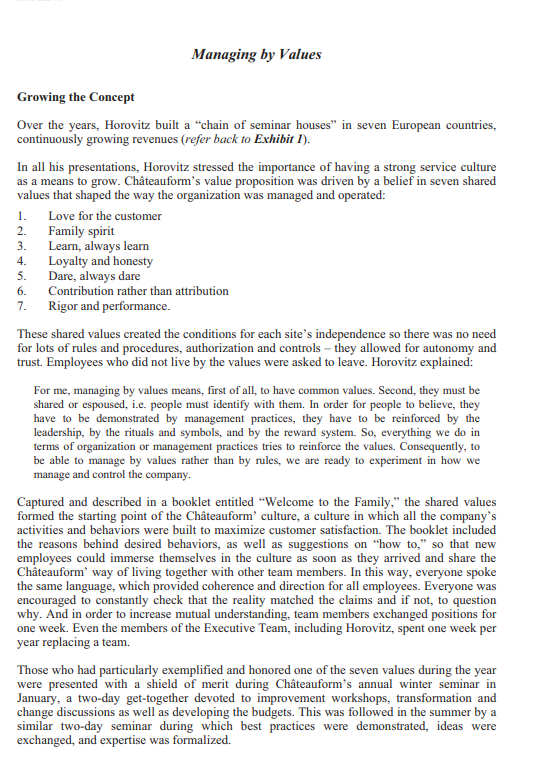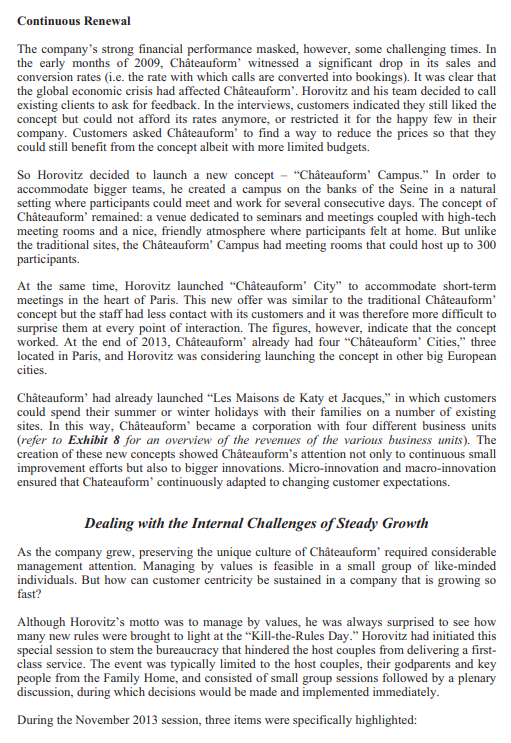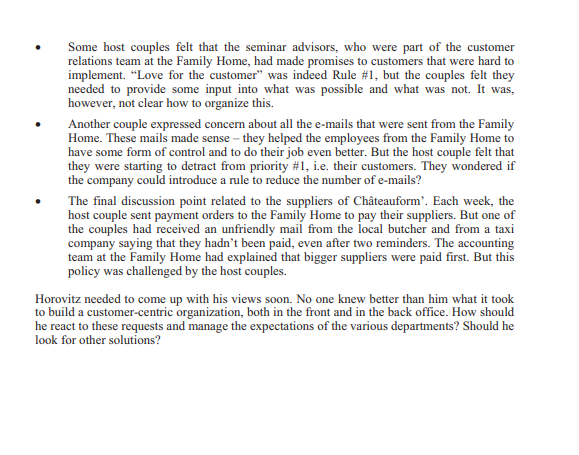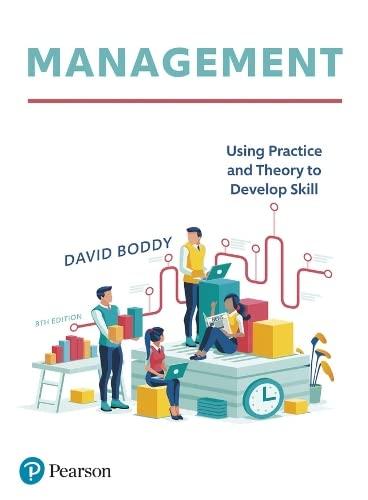Please help me out with this question for this case:
- In which industry does Chateauform compete?
- What can you say about the company's target group? Chateauform different from its competitors?
- What is Chateauformvalue proposition?
- What's the company operating model?
- How does Horovitz ensure that values are more that hollow statements displayed on the wall of a corporate boardroom?
Chateauform': The Concept Having taught in residential seminars for executive committees and business managers all over the world, Horovitz, a service marketing specialist, had noticed that appropriate venues for such seminars were hard to find. The meeting rooms in the hotels were frequently uncomfortable or poorly equipped and recreational activities to enable participants to unwind and chat informally were insufficient. Services lacked the flexibility to adapt to the ever- changing needs of the groups and last-minute requests from participants were time- consuming and difficult to satisfy. Any additional services that were requested were uniformly treated as extra, increasing costs uncontrollably and decreasing price transparency for the seminar organizers. Horovitz saw the opportunity to develop a completely new approach to residential seminars starting from the customer's needs. The unique concept of Chateauform' Home of Seminars was born out of his own country house in Neuville-Bosc. Clients were immediately enthusiastic and soon a series of venues specifically dedicated to corporate meetings, training events and workshops opened, first around Paris and then later across Europe (refer to Exhibits 2a and 2b for site locations). The Chateauform' Value Proposition Chateauform's prime customers were big multinational companies, with participants coming from all over the world. These companies had professional training departments used to organizing residential seminars for their senior executives and high-potential managers. Within this particular strategic segment, Chateauform' identified four stakeholder groups, each with its own distinctive needs. Chateauform' promised the participants a "feel at home, far from home" experience; it offered the organizers a hassle-free experience, ensuring that care was taken for the whole event. The decision makers got an all-inclusive price with no extra costs and no surprises. And it ensured the consultants and facilitators a high-tech, high- touch environment, conducive to productive meetings and seminars. Chateauform' sites were either serene chateaux or large, beautiful homes located in the countryside, yet in proximity to major cities and airports (refer to Exhibits 3 and 4 for pictures of sites). Each venue typically had 40 to 50 bedrooms. Simplicity, rather than luxury, permeated the decor and the properties' ambience, and all spaces and surroundings were well kept. Horovitz commented: We are not looking for luxury. In fact, if you look at the bedroom, it will have the bathrobe of a 4 or 5 star hotel but the shower of a 2 star hotel because when a participant goes to a seminar, he can wake up later (no need for transportation) and needs just a quick shower and the means to dry up quickly. We definitely consider our service to be around simplicity, conviviality and generosity, not luxury. Seven qualifiers were used to describe the value proposition of Chateauform' - generosity, conviviality, simplicity, flexibility, freedom, nature, high tech, high touch and human size. Central to the Chateauform' experience was complete freedom and flexibility. Participants were encouraged to use the premises as if they were at home. Meeting facilities included- 10 - IMD- Exhibit 1 Financial Overview of Chateauform' E million 2004 2005 2006 2007 2008 2009 2010 2011 2012 2013* CAGR (% ) Revenues 22.5 27.2 34.7 41.4 554 54.3 71.0 83.9 92.7 103.0 18.4% EBITDA 2.0 8.2 10.5 11.2 14.0 EBIT -0.1 -1.0 EBIT% -0.4% 5.5% 7.3% 7.3% 7.1% -1.9% 2% 5% 5% 7% EBT -0.1 2.0 2.0 Net income -0.9 2.2 2 -1.2 No. of sites 13.3% No. of rooms 620 768 825 1.1 10 1.332 1.530 1.749 1.919 2.256 15,4% No. of employees 283 376 367 438 575 569 727 818 865 900 13.7% Source: Company information 2013 EBITDA, EBIT and EBT are pro forma figures, considering all new sites open year round at normal occupancy rate\f\fExhibit 4 A Closer Look at the Facilities The home (Chateau de Marcil - FR) Meeting room (Schloss Ahrentahl - GER) Bedroom (Chateau de Nointel - FR) Meeting room (Chalet de Champery - CH) Dining area (La Finca El Bosque - ESP) Dining area (Chateau de Rochefort - FR) Relaxation (Chateau de Crecy - FR) Relaxation (La Forteresse de Mello - FR) O O Source: Company websiteExhibit 5 A Warm Welcome Dear Kurt, Welcome back home ! We are very happy to see you again at la Finca As you know this home in your home; to do wot hesitate to open doors end eujoy Queeything you coul ! All the team join two to wish you a wey good seminar. Exhibit 6 "Sweet and Sour" Evaluation Form Your rural saidation O O O O O O O O O O O O O The seminar passion - Ther site ooo0 O O O O you wish to nothe news from Chateauforms : please have in your Would you return - Ther skankce O Will you moonend Chakrayrm - The meds snacks oooooo0 Pran we could contact on your bstuff First since Nanke dinner's Company parenttion arrive Phone : Fax E-mail Thank you very much for your help Source: Company informationExhibit 7 Knight of the Fifth Year Source: Company information Exhibit 8 Revenue Evolution of Various Chateauform' Concepts E million 2012 2013 Evolution 2014* Evolution Les Maisons du Seminaire 72.5 77.3 86.3 2% City 8.6 12.3 44% 18.0 46% Campus 3.9 4.5 14% 5.2 16% Les maisons de Katy & 1.7 1.9 10% 2.1 12% Jacques Total 86.7 96.0 1 1% 1 11.6 16% Rebilling animation & 6.0 7.0 7.8 taxi Total revenues 92.7 103.0 1 1% 119.4 16% * Estimates for 2014 Source: Company informationChateauform': The Concept Having taught in residential seminars for executive committees and business managers all over the world, Horovitz, a service marketing specialist, had noticed that appropriate venues for such seminars were hard to find. The meeting rooms in the hotels were frequently uncomfortable or poorly equipped and recreational activities to enable participants to unwind and chat informally were insufficient. Services lacked the flexibility to adapt to the ever- changing needs of the groups and last-minute requests from participants were time- consuming and difficult to satisfy. Any additional services that were requested were uniformly treated as extra, increasing costs uncontrollably and decreasing price transparency for the seminar organizers. Horovitz saw the opportunity to develop a completely new approach to residential seminars starting from the customer's needs. The unique concept of Chateauform' Home of Seminars was born out of his own country house in Neuville-Bosc. Clients were immediately enthusiastic and soon a series of venues specifically dedicated to corporate meetings, training events and workshops opened, first around Paris and then later across Europe (refer to Exhibits 2a and 2b for site locations). The Chateauform' Value Proposition Chateauform's prime customers were big multinational companies, with participants coming from all over the world. These companies had professional training departments used to organizing residential seminars for their senior executives and high-potential managers. Within this particular strategic segment, Chateauform' identified four stakeholder groups, each with its own distinctive needs. Chateauform' promised the participants a "feel at home, far from home" experience; it offered the organizers a hassle-free experience, ensuring that care was taken for the whole event. The decision makers got an all-inclusive price with no extra costs and no surprises. And it ensured the consultants and facilitators a high-tech, high- touch environment, conducive to productive meetings and seminars. Chateauform' sites were either serene chateaux or large, beautiful homes located in the countryside, yet in proximity to major cities and airports (refer to Exhibits 3 and 4 for pictures of sites). Each venue typically had 40 to 50 bedrooms. Simplicity, rather than luxury, permeated the decor and the properties' ambience, and all spaces and surroundings were well kept. Horovitz commented: We are not looking for luxury. In fact, if you look at the bedroom, it will have the bathrobe of a 4 or 5 star hotel but the shower of a 2 star hotel because when a participant goes to a seminar, he can wake up later (no need for transportation) and needs just a quick shower and the means to dry up quickly. We definitely consider our service to be around simplicity, conviviality and generosity, not luxury." Seven qualifiers were used to describe the value proposition of Chateauform' - generosity, conviviality, simplicity, flexibility, freedom, nature, high tech, high touch and human size. Central to the Chateauform' experience was complete freedom and flexibility. Participants were encouraged to use the premises as if they were at home. Meeting facilities includedlarge auditoriums as well as board rooms and plenty of seating areas suitable for small group discussions. Each plenary room also included the latest audio-visual equipment. Meeting rooms could be configured as the client desired - U-shape, theatre-style, or even in a circle with floor cushions, bean bags and poufs. Participants were free to enjoy the rural surroundings; each venue provided umpteen choices for leisure, sport and relaxation. From walking or cycling in the private park or countryside, to swimming, archery or impromptu table tennis tournaments - all activities were readily accessible or quickly arranged at short notice. Each venue also worked with partner companies to provide clients with an array of team activities, such as wine-tasting or painting workshops. Meals at Chateauform' were not a functional but a culinary experience and a reflection of the simplicity and generosity imbedded in the Chateauform' experience. After dinner, guests could relax in the various lounges with open bars, enjoy a game of billiards or pool, or engage in a board game together. One site even offered massage bath tubs with 150 jets. Another offered water beds with jets for a full body massage in 10 minutes. All these Chateauform': activities were free of charge for participants, strengthening the key message of "Feel at home far from home." There were no hidden surprises for the decision makers when it came to the price of a seminar package. The average cost per participant for one night was (220 to 6340, slightly below the rate of a four-star hotel, but with no extras. Lodging, meals, open bar, high-tech meeting rooms, recreational and team-building activities: everything was included - even international phone calls made using the bedroom landlines. The concept of "everyday fair pricing" meant that no client could claim to have obtained a special price. Consequently, clients could rest assured that they would not pay more, or less, than any other client. Organizing around the Customer Delights Chateauform' recognized that all its customers - participants, organizers, decision makers and facilitators - had different specific needs. For each segment, the company defined a collection of best practices, referred to as the "Delights chart." The Delights chart explicitly stated the reason for every practice as well as what Chateauform' wanted each participant, organizer and/or facilitator to experience - perhaps a bottle of water and fresh fruit with a hand-written welcome note in the bedroom upon arrival, or a broad selection of freshly baked bread at each meal. The way this was carried out, however, was entirely up to the host couple and staff at each site. Training for newcomers to the Chateauform' family involved observing a site's operations and "chasing new delights," i.e. finding new ones not yet included in the chart. The chart was enhanced and updated by a committee every other year. Chateauform's top priority was always to maintain a high level of customer centricity and service quality for its clients. This started as soon as a potential customer called Chateauform' with a request to organize a seminar. From that first contact, potential clients immediately felt that the organization understood their needs in terms of planning and organizing a seminar or workshop.Customer Relations Team Organizers would first contact a seminar advisor from the customer relations team when planning a seminar at Chateauform'. These advisors maintained a database of the top 500 companies in each country, which included information on the organizers and decision makers. They were responsible for keeping abreast of the ongoing developments of a select group of accounts. The company realized that a good seminar is a well-prepared seminar. A specialized customer relations team tried to find out what the customer really needed and helped to find the venue with the appropriate conference and meeting rooms, the equipment required, and the right mix of leisure and team-building activities. The advisors also informed potential clients of the pricing of a seminar package. The Nanny Once a customer had decided to organize a seminar at Chateauform', a "nanny" would take over to discuss the specific needs of the various stakeholders involved (participants, organizers, decision makers, and facilitators). The nannies formed the logistic link between Chateauform's customer relations team, the client and the site. He or she understood all the client's and organizer's requirements, and transmitted all the information to the sites so that they could get ready to welcome the guests and prepare their stay. The week before the seminar, the nanny would visit the site and provide the host couple with all the details about the forthcoming group. Since Chateauform* collected information about every participant who visited, the host couple would know, among other things, if the customer had been satisfied during previous stays and any questions or remarks that had previously been made. The Trio Team The sites were considered "customer satisfaction centers," at the heart of which was the trio team - a host couple and a chef. The host couple, a husband-and-wife team, managed each property as if it were their own and looked after the well-being of the participants. They were usually experienced in the service industry, enthusiastic, friendly and entrepreneurial. They lived on the premises and were responsible for ensuring that everything worked and that their home was welcoming and well-kept. Their attentiveness and hospitality were key pillars of the Chateauform' experience (refer to Exhibit 5 for a typical welcome letter). They were completely in charge, with the ability and flexibility to make all the necessary decisions to provide customers with a superior experience. The chef played an important role as well. The kitchen was not hidden behind closed doors - participants could come and go as they pleased, adding to the "feel at home" atmosphere. During the seminar, everybody at the site would do their utmost to make the participants feel comfortable. Chateauform' was particularly attentive to loyal customers, going the extra mile to deal with their special wishes. It tried to develop a true relationship with its customers by maintaining a continuous dialogue. For example, if a customer was unable to organize a seminar due to a lack of availability, Chateauform' would inform this client about openings at other sites or alternative arrangements. Support from the Family Home The nannies and customer relations team worked from within the Family Home, which was the head office of Chateauform'. Its purpose was to unite the teams providing services and support to the sites - the couples, the chefs and their teams - for each country or region.Since each site was completely focused on delighting its own customers, the Family Home took care of customer relations in general as well as all other administrative tasks such as accounting, nancial and legal issues, insurance and operations, i.e. the logistics of the client prior to arrival, price negotiations and invoicing. it provided assistance with decoration, renovations and construction as well as hLunan resource services such as recruitment, dispute resolution and team training. And after a seminar, the naruty would call the organizer and ask for feedback. Street and Sour During the last day ofa seminar, participants were personally asked by the hosts to complete the \"Sweet and Sour\" satisfaction survey on site. it enabled them to rate their satisfaction regarding all aspects of their experience from the service and organization (welcome, cleanliness, meals} to the site (rooms, seminar rooms and leisure activities} {rer to Exhibit Ii}. They were also asked to indicate whether they would return and to what extent they would or would not recommend Chateauform' to others. As the \"Sweet and Sour" forms were completed on site, the host couple could use them right away to x any issues that participants had aleer them to. The response late for the \"Sweet and Sour" form was over "Ju. All the feedback received was systematically analyzed by the customer relations team and compiled into monthly reports The comments were compiled and formed tlle starting point for investments made each your at the sites. Although 96% of customers were either completely satised or very satised, Chateauform's goal was to achieve 1% satisfaction. From both the participants' evaluations and the feedback obtained 'om calls to the organisers, Chateauform' developed a service recovery plan. Built on a culture of extreme customer focus, Chateauform' focused on continuously improving its offer to customers to make the overall service better tailored to their needs. This focus went hand in hand with constantly questioning its cLu'rent approach and offering. Nothing was sacred; everything was up for a challenge. Customer centricity required continuously listening to customer demands and feedback. ht Chateauform', that meant processing ve million \"Sweet and Sour\" customer satisfaction surveys every year. Furthermore, in order to gain an external perspective, Chateauform' also asked its employees for their feedback. They were encouraged to point out areas for improvement and to write them down in a \"Golden book,\" which was available at every site. Internal Customer Satisfaction Contrary to conventional site management, the host couples' objectives related to customer satisfaction rather than prots. The sites had budgets, and it was the Family Home that was responsible for revenues. The Family Home's internal customer satisfaction objective was to serve the sites. This policy showed that the sites were at the center of 'die company's customer centricity strategy. As l-Iorovitr put it, \"Without the sites, we are nothing." The Family Home asked its host couples and other employees for feedback on how well it served the sites; 20% of the Family Home employees' salary was determined by the internal customer satisfaction scores. According to Horovitz, this was a tough policy to implement but it showed Chateauform's commitment to its \"love for 'die customer": Profit is a consequence, and as such always shows up too late to make a difference. The key measure of success was always customer satisfaction, one customer at a time. Whereas only 30 minutes was spent on the financials during the budgeting process, hours were invested in improving the customer experience. During performance measurement, very little focus was put on competition, although the company did employ mystery shoppers to check whether Chateauform' prices were still acceptable. HR Practices Chateauform' paid a lot of attention to hiring the right people. Every new host couple was interviewed by five experienced couples, and the same procedure applied to selecting a chef. If one of them said "no," the couple or chef was not hired. New couples and chefs attended "flying school" for two to six months, going from place to place to observe and write an "astonishment report." This allowed newcomers not only to familiarize themselves with the practices but also to provide an unbiased, fresh look at all Chateauform's sites. Only after "flying school" were they offered the keys to their homes. All host couples were also placed under the protection of a godfather or godmother. When they arrived at their new house, the godparent helped them to make the transition during a period of three months. Godparents were linked to a particular site - not to a couple - so they had a history with the particular property and its staff. They helped prevent new host couples from making the same mistakes as others before them, and remained available to provide a sounding board or advice for any problem at the site, be it with an employee or any other issue. To top off the strenuous recruitment and training practices, Chateauform' implemented strong reward and incentive policies. Salaries contained both a variable and a fixed element. The variable remuneration could represent up to 20% of the fixed income and was driven by internal or external customer satisfaction scores. In addition, everyone was paid a bonus if the occupancy rate at the sites was above the budgeted rate (set at 70%). Chateauform* also paid significant attention to non-financial rewards. Employees received a booklet at the end of the year with an overview of all the "sweet" notes. Chateauform' offered a collection of t-shirts (3, 6, 12 months) to every couple's child born in Chateauform'. Employees who worked for the company for 5, 10, 15 and 20 years were celebrated and received a special distinction, for example employees who had worked for the company for five years were called "Knights of the Fifth Year" and received a helmet as a present (refer to Exhibit 7). There were no bosses at Chateauform', or rather the customer was the only boss, not the host couple or the chef, which is why the company did not use formal titles.Managing by Values Growing the Concept Over the years, Horovitz built a "chain of seminar houses" in seven European countries, continuously growing revenues (refer back to Exhibit 1). In all his presentations, Horovitz stressed the importance of having a strong service culture as a means to grow. Chateauform's value proposition was driven by a belief in seven shared values that shaped the way the organization was managed and operated: 1. Love for the customer 2. Family spirit 3. Learn, always learn 4. Loyalty and honesty 5. Dare, always dare 6. Contribution rather than attribution 7. Rigor and performance. These shared values created the conditions for each site's independence so there was no need for lots of rules and procedures, authorization and controls - they allowed for autonomy and trust. Employees who did not live by the values were asked to leave. Horovitz explained: For me, managing by values means, first of all, to have common values. Second, they must be shared or espoused, i.e. people must identify with them. In order for people to believe, they have to be demonstrated by management practices, they have to be reinforced by the leadership, by the rituals and symbols, and by the reward system. So, everything we do in terms of organization or management practices tries to reinforce the values. Consequently, to be able to manage by values rather than by rules, we are ready to experiment in how we manage and control the company. Captured and described in a booklet entitled "Welcome to the Family," the shared values formed the starting point of the Chateauform' culture, a culture in which all the company's activities and behaviors were built to maximize customer satisfaction. The booklet included the reasons behind desired behaviors, as well as suggestions on "how to," so that new employees could immerse themselves in the culture as soon as they arrived and share the Chateauform' way of living together with other team members. In this way, everyone spoke the same language, which provided coherence and direction for all employees. Everyone was encouraged to constantly check that the reality matched the claims and if not, to question why. And in order to increase mutual understanding, team members exchanged positions for one week. Even the members of the Executive Team, including Horovitz, spent one week per year replacing a team. Those who had particularly exemplified and honored one of the seven values during the year were presented with a shield of merit during Chateauform's annual winter seminar in January, a two-day get-together devoted to improvement workshops, transformation and change discussions as well as developing the budgets. This was followed in the summer by a similar two-day seminar during which best practices were demonstrated, ideas were exchanged, and expertise was formalized.Continuous Renewal The company's strong financial performance masked, however, some challenging times. In the early months of 2009, Chateauform' witnessed a significant drop in its sales and conversion rates (i.e. the rate with which calls are converted into bookings). It was clear that the global economic crisis had affected Chateauform'. Horovitz and his team decided to call existing clients to ask for feedback. In the interviews, customers indicated they still liked the concept but could not afford its rates anymore, or restricted it for the happy few in their company. Customers asked Chateauform' to find a way to reduce the prices so that they could still benefit from the concept albeit with more limited budgets. So Horovitz decided to launch a new concept - "Chateauform' Campus." In order to accommodate bigger teams, he created a campus on the banks of the Seine in a natural setting where participants could meet and work for several consecutive days. The concept of Chateauform' remained: a venue dedicated to seminars and meetings coupled with high-tech meeting rooms and a nice, friendly atmosphere where participants felt at home. But unlike the traditional sites, the Chateauform' Campus had meeting rooms that could host up to 300 participants. At the same time, Horovitz launched "Chateauform' City" to accommodate short-term meetings in the heart of Paris. This new offer was similar to the traditional Chateauform concept but the staff had less contact with its customers and it was therefore more difficult to surprise them at every point of interaction. The figures, however, indicate that the concept worked. At the end of 2013, Chateauform' already had four "Chateauform' Cities," three located in Paris, and Horovitz was considering launching the concept in other big European cities. Chateauform' had already launched "Les Maisons de Katy et Jacques," in which customers could spend their summer or winter holidays with their families on a number of existing sites. In this way, Chateauform" became a corporation with four different business units (refer to Exhibit & for an overview of the revenues of the various business units). The creation of these new concepts showed Chateauform's attention not only to continuous small improvement efforts but also to bigger innovations. Micro-innovation and macro-innovation ensured that Chateauform* continuously adapted to changing customer expectations. Dealing with the Internal Challenges of Steady Growth As the company grew, preserving the unique culture of Chateauform" required considerable management attention. Managing by values is feasible in a small group of like-minded individuals. But how can customer centricity be sustained in a company that is growing so fast? Although Horovitz's motto was to manage by values, he was always surprised to see how many new rules were brought to light at the "Kill-the-Rules Day." Horovitz had initiated this special session to stem the bureaucracy that hindered the host couples from delivering a first- class service. The event was typically limited to the host couples, their godparents and key people from the Family Home, and consisted of small group sessions followed by a plenary discussion, during which decisions would be made and implemented immediately. During the November 2013 session, three items were specifically highlighted:Some host couples felt that the seminar advisors, who were part of the customer relations team at the Family Home, had made promises to customers that were hard to implement. "Love for the customer" was indeed Rule #1, but the couples felt they needed to provide some input into what was possible and what was not. It was, however, not clear how to organize this. Another couple expressed concern about all the e-mails that were sent from the Family Home. These mails made sense - they helped the employees from the Family Home to have some form of control and to do their job even better. But the host couple felt that they were starting to detract from priority #1, i.e. their customers. They wondered if the company could introduce a rule to reduce the number of e-mails? The final discussion point related to the suppliers of Chateauform'. Each week, the host couple sent payment orders to the Family Home to pay their suppliers. But one of the couples had received an unfriendly mail from the local butcher and from a taxi company saying that they hadn't been paid, even after two reminders. The accounting team at the Family Home had explained that bigger suppliers were paid first. But this policy was challenged by the host couples. Horovitz needed to come up with his views soon. No one knew better than him what it took to build a customer-centric organization, both in the front and in the back office. How should he react to these requests and manage the expectations of the various departments? Should he look for other solutions
